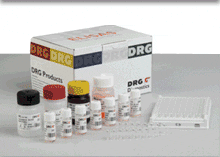14-Mar-2024
DRG erneuert die Vertriebspartnerschaft mit MERCODIA für den deutschen Markt.
Mehr...
23-Oct-2023
DRG ist wieder auf der MEDICA vertreten!
Sie finden uns in Halle 3, Stand A69.
Mehr...
29-Sep-2023
Treffen Sie DRG auf dem DKLM-Kongress in Mannheim
Deutscher Kongress fuer Laboratoriumsmedizin 2023
Mehr...
28-Sep-2023
Diagnostics-4-Future
DRG ist offizieller Partner der Konferenz in Konstanz, 17.-18. Oktober
Mehr...
27-Sep-2023
Spotlight auf den DRG CMV IgG Buccal Swab ELISA
Erfahren Sie mehr über den EINZIGARTIGEN Test von DRG
Mehr...
28-Oct-2022
DRG stellt wieder auf der MEDICA aus!
Sie finden uns in Halle 3, Stand A69.
Mehr...
04-Oct-2022
Deutscher Kongress für Laboratoriumsmedizin - DGKL
Treffen Sie DRG in Mannheim
Mehr...
19-Jul-2022
Diagnostics-4-Future 2022
DRG ist Partner der Konferenz in Konstanz im Oktober
Mehr...
28-Apr-2022
Neues Zertifikat EN ISO 13485:2016
Mehr...
29-10-2021
MEDICA 2021
Treffen Sie DRG wieder auf dieser Leitmesse in Düsseldorf
Mehr...
30-Aug-2021
NEU aus der DRG ELISA-Entwicklung:
Estriol total
Mehr...
25-Aug-2021
Diagnostics-4-Future
DRG ist Partner der Konferenz in Konstanz im Oktober 2021
Mehr...
19-Nov-2020
NEU aus der DRG ELISA-Entwicklung -
Zwei SARS-CoV-2 (RBD) Antikörper ELISAs: IgG quantitative und Total (IgA, IgM, IgG)
Mehr...
24-Apr-2020
DRG erhält Gütesiegel „Innovativ durch Forschung“
Mehr...
17-Feb-2020
NEU: Pankreatische Elastase (Stuhl) - vollautomatisch mit DRG:HYBRiD-XL
Mehr...
21-Okt-2019
Präeklampsie-Tests PlGF wurde in den EBM aufgenommen
Mehr...
14-Okt-2019
Besuchen Sie uns auf der MEDICA 2019
Stand 3/A69!
Mehr...
04-Apr-2019
Praeeklampsie - Ein wichtiges Thema fuer alle Schwangeren!
PLGF ELISA ist der passende Marker dazu.
Mehr...
06-Nov-2018
Zwei neue DRG ELISAs vorgestellt:
Freies T3 und Freies T4!
Mehr...
18-Oct-2018
Besuchen Sie uns auf der MEDICA!
Halle 3 / Stand A69
Mehr...
03-Sep-2018
Neue Diabetes Kits vorgestellt:
Ultrasensitiv Insulin & C-Peptide
Mehr...
04-Jul-2018
Besuchen Sie DRG auf der AACC
in Chicago, Stand 3438!
Mehr...
27-Feb-2018
Neuer Tumormarker fuer DRG:HYBRiD-XL: PSA
Mehr...
23-Feb-2018
Neuer DRG ELISA: AMH
Neuer ELISA für die Bestimmung von Anti-Müller Hormon
Mehr...
18-Dec-2017
DRG stellt aus auf der MEDLAB 2018 in Dubai
Besuchen Sie uns!
Mehr...
24-Oct-2017
Besuchen Sie DRG auf der MEDICA 2017
Halle 3 / Stand A69
Mehr...
04-Aug-2017
Neue Assays: Beta hCG und Freies Estriol fuer DRG:HYBRiD-XL!
Vorgestellt auf der AACC!
Mehr...
27-Jul-2017
DRG auf der AACC 2017!
Besuchen Sie unseren Stand Nr. 5521 in San Diego
Mehr...
21-July-2017
Optimierter Estron Speichel ELISA
korreliert sehr gut mit LC/MS
Mehr...
26-May-2017
Dr. Geacintov 1930-2017
Mit tiefem Bedauern müssen wir darüber informieren, dass unser Präsident und Inhaber, Herr Dr. Cyril Geacintov, verstorben ist.
Mehr...
23-May-2017
DRG auf der EuroMedLab 2017!
Besuchen Sie uns am Stand Nr. 24.
Mehr...
28-Feb-2017
DRG wieder Aussteller auf der MEDLAB Asia Pacific in Singapur!
Besuchen Sie uns am Stand Q11.
Mehr...
17-Jan-2017
DRG ist Aussteller auf der MEDLAB Dubai 2017!
Mehr...
21-Oct-2016
Neue Publilkation
TM-CA72-4 als Tumor Marker für Ovarialkarzinom!
Mehr...
12-Oct-2016
Besuchen Sie uns auf der MEDICA 2016
Halle 3 / Stand A69
Mehr...
17-Aug-2016
Neuer DRG ELISA: Salivary Progesterone HS ELISA
Perfekte Korrelation zu LC-MS/MS!
Mehr...
13-Jul-2016
Calprotectin automatisiert mit DRG:HYBRiD-XL!
Mehr...
30-Jun-2016
DRG auf der AACC 2016!
Besuchen Sie unseren Stand Nr. 3713 in Philadelphia
Mehr...
01-Jun-2016
Neuer Assay: AFP fuer DRG:HYBRiD-XL!
Mehr...
31-May-2016
DEQAS Ringversuch
25-OH Vitamin D (total) ELISA hat erfolgreich den DEQAS Ringversuch bestanden!
Mehr...
25-May-2016
Messe-Report HOSPITALAR 2016
Erfolgreicher Messeauftritt auf der Messe in Brasilien!
Mehr...
31-Mar-2016
Treffen Sie DRG @ European Iron Club in Innsbruck
7. - 10. April 2016
Mehr...
12-Feb-2016
Preisverleihung des German Design Award 2016 in Frankfurt!
Mehr...
10-Feb-2016
DRG ist Aussteller auf der MEDLAB Asia Pacific in Singapur!
Besuchen Sie uns am Stand J37.
Mehr...
05-Jan-2016
Hepcidin 25 (bioactive) HS
wurde beim ASH Meeting in Orlando, (USA) im Dezember präsentiert.
Mehr...
21-Dec-2015
Neue Assays: LH und Prolaktin für DRG:HYBRiD-XL!
Mehr...
14-Dec-2015
DRG ist Aussteller auf der ARAB Health 2016!
Besuchen Sie unseren Stand in Halle Z6 A19.
Mehr...
12-Nov-2015
NEU: DHT-optimized ELISA
Verbesserter Assay zur Bestimmung von 5α-Dihydrotestosteron!
Mehr...
28-Oct-2015
Hepcidin 25 (bioaktiv)
mit DRG:HYBRiD-XL erstmalig automatisiert!
Mehr...
26-Oct-2015
German Design Award 2016
DRG:HYBRiD-XL ist ausgezeichnet!
Mehr...
20-Oct-2015
Besuchen Sie uns auf der MEDICA 2015
Halle 3 / Stand A69
Mehr...
06-Oct-2015
DGKL 2015
Treffen Sie DRG beim DGKL Kongress in Leipzig!
Mehr...
03-Sep-2015
Neuer Assay: Insulin fuer DRG:HYBRiD-XL!
Mehr...
03-Aug-2015
German Design Award 2016
DRG:HYBRiD-XL ist nomiert!
Mehr...
24-Jun-2015
DRG auf der AACC 2015!
Besuchen Sie unseren Stand Nr. 819 in Atlanta
Mehr...
27-May-2015
Messe-Report HOSPITALAR 2015
Erfolgreicher Messeauftritt auf der Messe in Brasilien!
Mehr...
31-Mar-2015
Neuer ELISA
Hepcidin 25 (bioactive) HS ELISA - verbesserte Sensitivitaet!
Mehr...
27-Feb-2015
CRP-HS:
Neuer Parameter fuer DRG:HYBRiD-XL ab sofort verfuegbar!
Mehr...
06-Feb-2015
DRG Events 2015
Die neue Liste der DRG Events ist jetzt online!
Mehr...
27-Jan-2015
Pressemitteilung:
Martina Werner, Mitglied des Europaeischen Parlaments, zu Besuch bei DRG!
Mehr...
12-Jan-2015
HEPCIDIN
Neue Publikation veroeffentlicht im "American Society of Hematology"
Mehr...
08-Jan-2015
DRG ist Aussteller auf der ARAB HEALTH 2015!
Mehr...
28-Nov-2014
Neue Assays DHEA und DHEA-S fuer DRG:HYBRiD-XL ab sofort verfuegbar!
Mehr...
24-Nov-2014
Produktuebersicht Laborautomationssysteme
DRG:HYBRiD-XL als Loesung fuer das kleine Labor
Mehr...
06-Nov-2014
Neuer Assay: D-dimer für DRG:HYBRiD-XL!
Mehr...
24-Okt-2014
MEDICA 2014
Die DRG Gruppe wird auch dieses Jahr mit einem grossen Stand vertreten sein
Mehr...
17-Okt-2014
Neue Assays TSH und freies T4 fuer DRG:HYBRiD-XL ab sofort verfuegbar!
Mehr...
08-Okt-2014
Freies Testosteron fuer DRG:HYBRiD-XL
Der Assay kann ab sofort bestellt werden!
Mehr...
09-Sep-2014
DGKL in Mannheim
Besuchen Sie den DRG Stand auf dem DGKL Kongress.
Mehr...
20-Aug-2014
NEU: HbA1c fuer DRG:HYBRiD-XL
Der Assay kann ab sofort bestellt werden!
Mehr...
17-Jul-2014
Cystatin C
Neuer Parameter fuer DRG:HYBRiD-XL ab sofort verfuegbar!
Mehr...
01-Jul-2014
DRG auf der AACC 2014!
Besuchen Sie unseren Stand Nr. 2431 in Chicago
Mehr...
17-Jun-2014
Neuer Assay fuer DRG:HYBRiD-XL:
Androstendion ab sofort verfuegbar!
Mehr...
13-Jun-2014
DRG ist Gewinner des MDEA 2014 Awards
DRG:HYBRiD-XL wurde als Gewinner des MDEA 2014 Award in Bronze ausgewaehlt!
Mehr...
27-May-2014
Messe-Report HOSPITALAR 2014
DRG hat den DRG:HYBRiD-XL mit den neuesten Assays dem lateinamerikanischen Markt auf der HOSPITALAR vorgestellt.
Mehr...
26-May-2014
Neue Assays fuer DRG:HYBRiD-XL!
T3, T4 und freies T3 sind ab sofort verfuegbar!
Mehr...
12-May-2014
DRG Veranstaltungen im Mai 2014
Besuchen Sie uns am DRG Stand auf der HOSPITALAR und House-of-Pharma
Mehr...
09-May-2014
DRG:HYBRiD-XL ist Finalist bei MDE Awards
Der neue vollautomatische Analyzer DRG:HYBRiD-XL ist als Finalist beim Medical Design Excellence Awards 2014 nominiert.
Mehr...
30-Apr-2014
ECE 2014
DRG stellt aus auf dem 16. europaeischen Kongress fuer Endokrinologie in Wroclaw, Polen, aus.
Mehr...
14-Feb-2014
DRG Events 2014
Die neue Liste der DRG Events ist nun online!
Mehr...
09-Jan-2014
ARAB HEALTH 2014
Die DRG wird auch im neuen Jahr auf der ARAB HEALTH in Dubai mit einem eigenen Stand vertreten sein
Mehr...
02-Dec-2013
DRG:HYBRiD-XL: Erstes Testpanel wird vorgestellt
Ab sofort sind die ersten Assays für DRG:HYBRiD-XL verfügbar!
Mehr...
28-Nov-2013
DRG hat zur MEDICA zwei neue Filme vorgestellt
Schauen Sie doch mal vorbei!
Mehr...
14-Oct-2013
MEDICA 2013
Die DRG Gruppe wird auch dieses Jahr mit einem grossen Stand vertreten sein
Mehr...
30-Sep-2013
DGKL in Dresden
Besuchen Sie den DRG Stand auf dem DGKL Kongress!
Mehr...
09-Aug-2013
Messe-Bericht SMTLSA 2013
DRG and BIOCOM haben sich erstmalig gemeinsam auf dem Laborkongress SMTLSA in Kapstadt praesentiert
Mehr...
23-Jul-2013
Neuer DRG Flyer online
DRG hat die neue Broschüre zum Thema Eisenstoffwechsel und DRG Hepcidin ELISA online gestellt!
Mehr...
05-Jul-2013
DRG Messen im Juli / August 2013
Besuchen Sie uns am DRG Stand auf der AACC oder SMTLSA
Mehr...
31-May-2013
CTGF ELISA von DRG als Biomarker für chronische Lebererkrankungen!
Eine neue Studie zeigt, dass der CTGF ELISA hilfreich sein kann für nicht-invasive Überwachung von chronische Lebererkrankungen.
Mehr...
29-Apr-2013
Große Eröffnungsfeier in Spingfield, NJ
DRG Intl. feiert die Eröffnung der neuen Firmenzentrale in New Jersey
Mehr...
05-Apr-2013
DRG Messen im April / Mai 2013
Besuchen Sie uns am DRG Stand auf der ECCMID, EUROMEDLAB oder HOSPITALAR
Mehr...
08-Mar-2013
Chlamydia und TORCH ELISAs CE zertifiziert!
10 infektionsserologische DRG ELISAs sind erfolgreich durch den TÜV Rheinland zertifiziert!
Mehr...
05-Mar-2013
Progesteron und Cortisol ELISA von DRG erfolgreich getestet bei schottischer Studie mit Walen und Robben
Studienergebnisse werden auf Konferenz in Portugal präsentiert
Mehr...
07-Feb-2013
DRG @ ARAB HEALTH 2013
DRG auf eine der größten Medizinmessen vertreten: Arab Health in Dubai
Mehr...
06-Dec-2012
Mehr neue DRG Flyer online
DRG hat eine neue Broschüre zum Thema Aldosteron!
Mehr...
28-Nov-2012
Neuer DRG Flyer online
DRG hat eine neue Broschüre zum Thema 25-OH-Vitamin D!
Mehr...
02-Nov-2012
MEDICA 2012
DRG hat eine spektakulaere, mediale Show fuer Sie vorbereitet!
Mehr...
31-Oct-2012
Neuer DRG Flyer online
DRG hat die neue Broschüre zum Thema Alzheimer Forschung online gestellt!
Mehr...
15-Oct-2012
DRG:HYBRiD-XL
erstmalig ausgestellt auf der "Pharmed and Healthcare Vietnam"
Mehr...
20-Sep-2012
DRG:HYBRiD-XL® hat CE!
DRG´s vollautomatischer Analyzer erfüllt die Standards der CE Regularien!
Mehr...
30-Jul-2012
Sommerzeit mit DRG
Die DRG wünscht allen Kunden eine schöne Ferienzeit!
Mehr...
22-Jun-2012
AACC 2012
Die DRG Gruppe ist Aussteller auf der AACC Clinical Lab Expo in Los Angeles! Verpassen Sie nicht die Live Demos am Stand und unsere Poster Session!
Mehr...
15-Jun-2012
DRG & VDGH
Neue VDGH Imagebroschüre setzt DRG:HYBRID-XL bildgewaltig in Szene!
Mehr...
25-May-2012
Messe-Bericht HOSPITALAR 2012
DRG und Biomedix verbuchen einen großen Erfolg beim ersten gemeinsamen Messeauftritt auf der HOSPITALAR 2012
Mehr...
11-May-2012
HOSPITALAR 2012
DRG wird den DRG:HYBRiD-XL® erstmalig dem südamerikanischen Markt vorstellen auf der HOSPITALAR in Sao Paulo, Brasilien
Mehr...
05-Mar-2012
MEDICAL FAIR INDIEN 2012
DRG hat in Kooperation mit dem indischen Partner Weldon Biotech auf der Medizinmesse MEDICAL FAIR INDIA ausgestellt
Mehr...
09-Jan-2012
ARAB HEALTH 2012
Die DRG wird auch im neuen Jahr auf der ARAB HEALTH in Dubai mit einem eigenen Stand vertreten sein.
Mehr...
07-Nov-2011
MEDICA 2011
Die DRG Gruppe wird auch dieses Jahr auf der MEDICA 2011 mit einem großen Stand vertreten sein.
Mehr...
21-Sep-2011
Alzheimer Forschung
DRG entwickelt den weltweit ersten Test zum Nachweis von Serum-Autoantikörpern gegen Amyloid Peptide
Mehr...
03-Sep-2011
DRG Neubau fertig gestellt!
Am 2. September wurde der DRG Erweiterungs-Neubau in der Frauenbergstrasse, Marburg, offiziell eingeweiht.
Mehr...
29-Jun-2011
AACC 2011
Die DRG Gruppe wird auch dieses Jahr auf der AACC Clinical Lab Expo 2011 mit einem Stand und einer Posterpräsentation vertreten sein.
Mehr...
23-May-2011
Medal of Honor
Cyril Geacintov, Präsident und CEO von DRG Intl. hat die “Ellis Island Medal of Honor” als besondere Anerkennung verliehen bekommen!
Mehr...
14-Apr-2011
Neues Zertifikat für DRG Liste B Produkte!
DRG kann nach dem gerade bestandenen Audit die Palette der CE genehmigten Liste B Produkte erweitern. Wir sind stolz unser neues Zertifikat zu präsentieren.
Mehr...
19-Jan-2011
DRG ist AEO zertifiziert!
Die DRG Instruments GmbH hat im Januar 2011 den AEO Status erhalten durch das Hauptzollamt Gießen.
Mehr...
29-Dec-2010
NEU: DRG Film MEDICA 2010
DRG hat 2010 auf der MEDICA ein ganz neues, innovatives Standkonzept vorgestellt. Überzeugen Sie sich! Sehen Sie den neuen Film!
Mehr...
13-Oct-2010
Grundstein gelegt - Die DRG investiert in die Zukunft
Die Marburger DRG Instruments GmbH erweitert ihren Firmensitz in der Frauenbergstraße. Rund 4,5 Millionen Euro werden in einen Anbau und neue Maschinen investiert.
Mehr...
11-Oct-2010
DRG übernimmt die ELISA Produktion von DIMA Diagnostica, einer Niederlassung von bioMérieux
DRG Instruments wird die Mikrotiterplatten Produktion, sowie die Lagerbestände und Rohmaterialien von DIMA übernehmen.
Mehr...
11-Aug-2010
DRG Renin-ELISA -
Der weltweit erste Sandwich-ELISA zur nicht-radioaktiven Quantifizierung von aktivem Renin
In den Vereinigten Staaten von Amerika leiden ungefähr ein Drittel der Erwachsenen an Bluthochdruck, ein Drittel davon sogar ohne Kenntnis ihrer Gefährdung.
Mehr...
21-Jul-2010
DRG stellt neuen Labor-Vollautomaten auf der AACC 2010 vor
DRG stellt einzigartigen vollautomatischer Random-Access Analyzer vor für die simultane Bestimmung von Immunoassays und Klinisch Chemische Parameter.
Mehr...
01-Apr-2010
DRG Prolaktin-ELISA zur Plasmamessung bei der Angoraziege
Die DRG International Inc. berichtet, dass Forscher den DRG Prolaktin-Testkit...
Mehr...
23-Dec-2009
DRG:HYBRiD-XL: DRG stellt neuen Labor-Vollautomaten auf der MEDICA 2009 vor
Einzigartiger vollautomatischer Random-Access Analyzer für Immunoassays und klinische Chemie ab 2011 verfügbar.
Mehr...
24-Aug-09
WELTWEIT ERSTER HEPCIDIN-TESTKIT JETZT ERHÄLTLICH!
Mit dem Testkit ist eine schnelle Diagnose von Störungen im Eisenstoffwechsel wie z. B. Hämochromatose und Anämie möglich.
Mehr...


